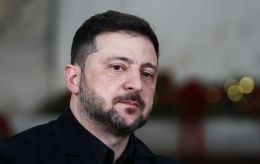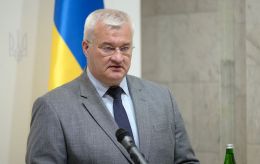Russians caught in сauldron in Kursk region: Expert predicts further actions
 Illustrative photo: Russian soldiers got encircled in the Kursk region (Getty Images)
Illustrative photo: Russian soldiers got encircled in the Kursk region (Getty Images)
Oleksandr Musiienko, head of the Center for Military and Legal Studies, reports in a comment to RBC-Ukraine that some Russian occupiers in the Kursk region have been encircled and are trying to escape the battlefield.
Musiienko confirmed rumors that Russians had been trapped in сauldron in the Kursk region. According to him, Ukrainian defenders are operating from two directions— from the Sumy region towards the village of Tyotkino in the Kursk region to the north and from the area of the village of Korenevo in the Kursk region further to the southwest. In this area, the Seym River lies to the north and east.
“This creates pressure. It's practically an encirclement,” Musiienko explained.
Attempts to escape by Russian Forces
He added that there is information that the Russians are attempting to escape via a bridge. While the bridge is unsuitable for heavy equipment, infantry can still use it. The bridge is significantly damaged but not destroyed, and Musiyenko does not rule out the possibility that it could still be completely destroyed.
The expert also mentioned that the occupiers were trying to use pontoon bridges to rescue their soldiers. The enemy is essentially trying to break out of the encirclement.
At the same time, some Russian soldiers continue to resist, particularly in the Tyotkino area, where well-trained enemy units are stationed, and fighting continues.
Ukraine's plan
The head of the Center for Military and Legal Studies pointed out that the Ukrainian military command avoids direct combat engagements if it can force the enemy to surrender or exhaust their ammunition. Therefore, the current operation aims to create "unbearable conditions" for the Russian soldiers.
Musiienko emphasized that it is currently difficult to say how many occupiers have been encircled. However, he believes there are two possible scenarios.
The first is that Ukrainian defenders will increase pressure, leading to an intensification of hostilities. The second scenario is that unbearable conditions will continue to be created for the Russians, leading some of their soldiers to surrender. As a result, Ukrainian defenders could gain control over a significant foothold.
The expert believes the current struggle aims to expand Ukrainian control to the west in the Glushkovo district, where a сauldron has been created for the enemy. This could extend the buffer zone in the Kursk region by another 30-40 kilometers.
“At a minimum, this zone will be established. If so, I think it will be for a long time. Ukraine would then be interested in Russia relocating its troops, ammunition, etc., there, trying to push Ukrainian forces out, but not using all their potential forces in the eastern Donetsk region,” Musiienko added.
He clarified that this situation in the Kursk region could last until the end of the year.
The expert also suggested that the defenders might continue their offensive operation. This is riskier, as it would require more soldiers.
“But imagine—taking Korenevo is one thing. It’s important. It’s a success. But what if it’s Rylsk? What if it’s Lgov? What if it’s Kurchatov? Or even Ukrainian forces coming within artillery range of targets in Kursk? That’s significant,” he said.
Background
It should be noted that Ukrainian defenders unexpectedly organized an operation in the Kursk region. The first rumors about this appeared online.
In just a few weeks, the Ukrainian Armed Forces have achieved significant success. They now control nearly 100 settlements.
In recent days, reports have emerged that Russian troops in the Kursk region have been surrounded. The Wall Street Journal, in particular, reported that thousands of occupiers are encircled.
These rumors were also confirmed by Andriy Kovalenko, the head of the Center for Countering Disinformation of the National Security and Defense Council.

